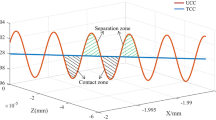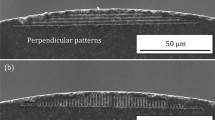Abstract
In this study, a new process of axial ultrasonic vibration-assisted extrusion cutting (AUV-EC) is proposed to prepare Al6061 alloy ultrafine-grained chip strips. The principles of AUV-EC are analyzed. The cutting motion trajectory equations of the main tool and the constraint tool during the AUV-EC process are established, and the theoretical cut marks on the chip surface are predicted. AUV-EC experiments are conducted to verify the theoretical cut marks on the chip surface and characterize the surface topography and microstructure of the chip strip samples. The results show that applying ultrasonic vibration with a frequency of 33 ~ 34.5 kHz and an amplitude of 1 ~ 6 μm in the AUV-EC process can improve the chip strip’s surface quality. Compared with traditional extrusion cutting (EC) chip samples, AUV-EC chip samples have better surface flatness and smoothness and lower surface defect ratios. The average grain sizes of the traditional EC and AUV-EC chip samples are approximately 164 nm and 135 nm, respectively. Many dynamic recovery grains are distributed in traditional EC chips, but there is only a small amount in AUV-EC chips. The x-ray diffraction (XRD) test finds that the AUV-EC chip has a higher dislocation density.














Similar content being viewed by others
References
Segal VM, Reznikov VI, Dobryshevshiy AE, Kopylov VI (1981) Plastic working of metals by simple shear. Russ Metall 1:99–105
Bridgman PW (1952) Studies in large plastic flow and fracture, vol 177. McGraw-Hill, USA,, New York. https://doi.org/10.4159/harvard.9780674731349
Nath C, Rahman M (2008) Effect of machining parameters in ultrasonic vibration cutting. Int J Mach Tools Manuf 48(9):965–974. https://doi.org/10.1016/j.ijmachtools.2008.01.013
Swaminathan S, Ravi Shankar M, Rao BC, Compton D, Chandrasekar W, King S, Trumble AH (2007) Severe plastic deformation (SPD) and nanostructured materials by machining. J Mater Sci 42:1529–1541. https://doi.org/10.1007/s10853-006-0745-9
Iglesias P, Moscoso W, Mann J et al (2008) Production analysis of new machining-based deformation processes for nanostructured materials. IntJ Mater Form 1(s1):459–462. https://doi.org/10.1007/s12289-008-0094-0
Sevier M, Yang HTY, Moscoso W, Chandrasekar S (2008) Analysis of severe plastic deformation by large strain extrusion machining. Metall Mater Trans A 39:2645–2655. https://doi.org/10.1007/s11661-008-9608-0
Bai X, Kustas A, Chandrasekar S, Trumble KP (2016) Large Strain Extrusion Machining on 6013 Aluminum Alloy. In Light Metals. 225–229, https://doi.org/10.1007/978-3-319-48251-4_38
Iglesias P, Bermúdez MD, Moscoso W et al (2010) Influence of processing parameters on wear resistance of nanostructured OFHC copper manufactured by large strain extrusion machining. Wear 268(1):178–184. https://doi.org/10.1016/j.wear.2009.07.009
Mert E, Moscoso W, Trumble KP et al (2012) Mechanics of large strain extrusion machining and application to deformation processing of magnesium alloys. Acta Mater. https://doi.org/10.1016/j.actamat.2012.01.018
Klenosky DR, Johnson DR, Chandrasekar S, Trumble KP (2017) Characterization of large strain Extrusion Machining (LSEM) of AA7050. Light metals 2017. Springer Int Publishing 301–304. https://doi.org/10.1007/978-3-319-51541-0_40
Wu YL (2017) The study of physicochemical properties and osseointegration of an ultrafine-grained titanium mini dental implant after morphology optimization [D]. Fourth Military Medical University
Azushima A, Kopp R, Korhonen A, Yang DY, Micari F, Lahoti GD, Groche P, Yanagimoto J, Tsuji N, Rosochowski A, Yanagida A (2008) Severe plastic deformation (SPD) processes for metals[J]. CIRP Ann 57(2):716–735
Ge Qiang E, Mostaed C, Zanella Y, Zhentao M, Vedani (2014) Ultra-fine Grained Degradable Magnesium for Biomedical Applications[J]. Rare Metal Mater Eng 43(011):2561–2566
Kim WJ, Sa YK (2006) Micro-extrusion of ecap processed magnesium alloy for production of high strength magnesium micro-gears [J]. Scripta Mater 54(7):1391–1395
Saldana C, Yang P, Mann JB, Moscoso W, Gill DD, Chandrasekar S, Trumble KP (2009) Micro-scale components from high-strength nanostructured alloys [J]. Mater Sci Eng A 503(1):17
Yin XL, Deng WJ, Zou Y et al (2019) Ultrafine grained Al 7075 alloy fabricated by cryogenic temperature large strain extrusion machining combined with aging treatment. Mater Sci Eng A 138106. https://doi.org/10.1016/j.msea.2019.138106
Shin SS, Kim WC, Kim KH et al (2015) Improvement of Riser Efficiency using high-intensity Ultrasonic Treatment in A356 Alloy. Mater Trans 56(9):1605–1608. https://doi.org/10.2320/matertrans.M2015141
Ahmadi F, Farzin M, Meratian M et al (2015) Improvement of ECAP process by imposing ultrasonic vibrations. Int J Adv Manuf Technol 79(1–4):503–512. https://doi.org/10.1007/s00170-015-6848-1
Liu YX, Suslov S, Han QY et al (2012) Microstructure of the pure copper produced by upsetting with ultrasonic vibration. Mater Lett. https://doi.org/10.1016/j.matlet.2011.08.086
Liu YX, Han QY, Hua L et al (2013) Numerical and experimental investigation of upsetting with ultrasonic vibration of pure copper cone tip. Ultrasonics 53(3):803–807. https://doi.org/10.1016/j.ultras.2012.11.010
Bagherzadeh S, Abrinia K, Liu Y et al The effect of combining high-intensity ultrasonic vibration with ECAE process on the process parameters and mechanical properties and microstructure of aluminum 1050. Int J Adv Manuf Technol, 2016:1–12, https://doi.org/10.1007/s00170-016-8779-x
Zhang X, Sui H, Zhang D et al (2017) Feasibility study of high-speed Ultrasonic vibration cutting Titanium Alloy[J]. J Mater Process Technol 247(19):111–120
Liu XF, Zhang JH et al (2019) Influence of tool material and geometry on micro-textured surface in radial ultrasonic vibration-assisted turning. Int J Mech Sci. https://doi.org/10.1016/j.ijmecsci.2019.01.027
Razavi H, Nategh MJ, Abdullah A (2012) Analytical modeling and experimental investigation of ultrasonic-vibration-assisted oblique turning, part III: experimental investigation. Int J Mech Sci. https://doi.org/10.1016/j.ijmecsci.2012.06.007
Chang L, Chengzu R, Guofeng W et al (2015) Study on surface defects in milling Inconel 718 super alloy. J Mech Sci Technol. https://doi.org/10.1007/s12206-015-0345-1
Muhammad R, Hussain MS, Maurotto A et al (2014) Analysis of a free machining α + β titanium alloy using traditional and ultrasonically assisted turning. J Mater Process Technol 214(4):906–915. https://doi.org/10.1016/j.jmatprotec.2013.12.002
Kumar VC, Hutchings IM (2004) Reduction of the sliding friction of metals by the application of longitudinal or transverse ultrasonic vibration. Tribol Int 37(10):833–840. https://doi.org/10.1016/j.triboint.2004.05.003
Kanani M, Sohrabi S, Ebrahimi R et al (2014) Continuous and ultra-fine grained chip production with large strain machining. J Mater Process Technol 214(8):1777–1786. https://doi.org/10.1016/j.jmatprotec.2014.03.028
Deshpande A, Tofangchi A, Hsu K (2019) Microstructure evolution of Al6061 and copper during ultrasonic energy assisted compression. Mater Charact 153. https://doi.org/10.1016/j.matchar.2019.05.005
Enayati HM, Abbasi-Baharanchi M, Karimzadeh F (2017) Mechanical and tribological behavior of severely plastic deformed Al6061 at cryogenic temperatures. Mater Sci Engineering: A. https://doi.org/10.1016/j.msea.2016.11.099
Liu HM, Cui H, Yang B et al (2004) Isothermal grain growth of reactive spray formed 7075 alloys in semi-solid state. J Univ Sci Technol Bei**g Mineral Metall Mater 11(5):411–414. https://doi.org/10.1080/02533839.2004.9670933
Rokni MR, Widener CA, Champagne VK et al (2015) Microstructure and mechanical properties of cold sprayed 7075 deposition during non-isothermal annealing. Surf Coat Technol 276:305–315. https://doi.org/10.1016/j.surfcoat.2015.07.016
Messerschmidt U (2010) Dislocation dynamics during plastic deformation[M]. Springer, New York
Acknowledgements
This work is supported by the National Nature Science Foundation of China (52105499).
Author information
Authors and Affiliations
Corresponding author
Ethics declarations
Competing of interest
We wish to draw the attention of the Editor to the following facts that may be considered as declaration of interest statement and to significant financial contributions to this work.
We confirm that the manuscript has been read and approved by all named authors and that there are no other persons who satisfied the criteria for authorship but are not listed. We further confirm that all have approved the order of authors listed in the manuscript of us.
We confirm that we have given due consideration to the protection of intellectual property associated with this work. There are no impediments to publication, including the timing of publication, with respect to intellectual property. In so doing, we confirm that we have followed the regulations of our institutions concerning intellectual property.
The Corresponding Author is the sole contact for the Editorial process. She is responsible for communication with the other authors about progress, submissions of revisions, and final approval of proofs. We confirm that we have provided a current, correct email address accessible by Corresponding Author and has been configured to accept email from Measurement.
Additional information
Publisher’s Note
Springer Nature remains neutral with regard to jurisdictional claims in published maps and institutional affiliations.
Rights and permissions
Springer Nature or its licensor (e.g. a society or other partner) holds exclusive rights to this article under a publishing agreement with the author(s) or other rightsholder(s); author self-archiving of the accepted manuscript version of this article is solely governed by the terms of such publishing agreement and applicable law.
About this article
Cite this article
Pi, Y., Gao, C. & Yin, X. Effect of axial ultrasonic vibration on the surface topography and microstructure of Al6061 chip in extrusion cutting. Int J Mater Form 17, 35 (2024). https://doi.org/10.1007/s12289-024-01837-9
Received:
Accepted:
Published:
DOI: https://doi.org/10.1007/s12289-024-01837-9




